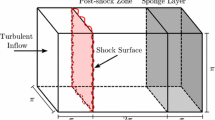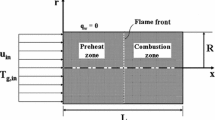Abstract
In this work, we investigate numerically the temporal evolution of Turbulent Kinetic Energy (TKE) of a chemically-reacting n-heptane and air mixture in statistically Homogeneous Isotropic Turbulence (HIT). Our specific focus is on the concurrent view of TKE evolution in both physical and scale (Fourier) spaces to identify the impact of reaction-induced heat release on turbulence. The simulation parameters are selected to represent the combustion characteristics of heavy hydrocarbon fuels under engine conditions. Results indicate that pressure dilatation work dominates the TKE evolution during the period of strong heat release and its dominance is attributed to the strong volumetric dilatation associated with the presence of reaction fronts in physical space. Viscous dissipation and viscous dilatation terms become much stronger with increasing heat release, primarily due to the increase in strain-rate and dilatation at the vicinity of the reaction fronts, but their magnitudes are still small compared to that of pressure dilatation work. In addition, the analysis in Fourier space shows that pressure dilatation work dominates the evolution of TKE not only in the mean, but also over a wide range of scales. The spectrum of pressure dilatation shows a power-law behavior, which is a direct consequence of the localized sheet-like reaction fronts in physical space. It is also shown that viscous dissipation spectrum initially removes kinetic energy at small scales when heat release is weak, but starts to remove kinetic energy at intermediate and later at large scales due to the presence of localized reaction fronts during the strong heat release period. More interestingly, it is observed that the inter-scale kinetic energy transfer spectrum moves energy from less dissipative scales (small scales) to scales where kinetic energy is more effectively removed by viscous dissipation work (large scales) during the period of strong heat release, which indicates possible up-scale kinetic energy transfer in Fourier space.











Similar content being viewed by others
References
Peters, N.: Turbulent combustion. Cambridge University Press, Cambridge (2000)
Haworth, D.C., Poinsot, T.J.: Numerical simulations of lewis number effects in turbulent premixed flames. J. Fluid Mech. 244, 405–436 (1992)
Trouvé, A., Poinsot, T.: The evolution equation for the flame surface density in turbulent premixed combustion. J. Fluid Mech. 278, 1–31 (1994)
Driscoll, J.F.: Turbulent premixed combustion: Flamelet structure and its effect on turbulent burning velocities. Progress Energy Combust. Sci. 34(1), 91–134 (2008)
Tahry, S.H.E., Rutland, C., Ferziger, J.: Structure and propagation speeds of turbulent premixed flames—a numerical study. Combust. Flame 83(1), 155–173 (1991)
Meneveau, C., Poinsot, T.: Stretching and quenching of flamelets in premixed turbulent combustion. Combust. Flame 86(4), 311–332 (1991)
Bilger, R., Pope, S., Bray, K., Driscoll, J.: Paradigms in turbulent combustion research. Proc. Combust. Inst. 30(1), 21–42 (2005)
Jaberi, F.A., Livescu, D., Madnia, C.K.: Characteristics of chemically reacting compressible homogeneous turbulence. Phys. Fluids 12(5), 1189–1209 (2000)
Martin, M.P., Candler, G.V.: Effect of chemical reactions on decaying isotropic turbulence. Phys. Fluids 10(7), 1715–1724 (1998)
Lee, K., Girimaji, S.S.: Flow-thermodynamics interactions in decaying anisotropic compressible turbulence with imposed temperature fluctuations. Theor. Comput. Fluid Dyn. 27(1), 115–131 (2013)
Lee, K., Yu, D., Girimaji, S.S.: Lattice boltzmann dns of decaying compressible isotropic turbulence with temperature fluctuations. Int. J. Comput. Fluid Dyn. 20(6), 401–413 (2006)
Veynante, D., Vervisch, L.: Turbulent combustion modeling. Progress Energy Combust. Sci. 28(3), 193–266 (2002)
Knaus, R., Pantano, C.: On the effect of heat release in turbulence spectra of non-premixed reacting shear layers. J. Fluid Mech. 626, 67–109 (2009)
Kolla, H., Hawkes, E.R., Kerstein, A.R., Swaminathan, N., Chen, J.H.: On velocity and reactive scalar spectra in turbulent premixed flames. J. Fluid Mech. 754, 456–487 (2014)
Towery, C.A.Z., Poludnenko, A.Y., Urzay, J., Ihme, M., Hamlington, P.E.: Spectral energy dynamics in premixed flames. Center for Turbulence Research Proceedings of the Summer Program, pp. 159–168 (2014)
Towery, C.A.Z., Poludnenko, A.Y., Urzay, J., O’Brien, J., Ihme, M., Hamlington, P.E.: Spectral kinetic energy transfer in turbulent premixed reacting flows. Phys. Rev. E 93(053), 115 (2016)
Menon, S.K., Boettcher, P.A., Ventura, B., Blanquart, G.: Hot surface ignition of n-hexane in air. Combust. Flame 163, 42–53 (2016)
Blanquart, G., Pepiot-Desjardins, P., Pitsch, H.: Chemical mechanism for high temperature combustion of engine relevant fuels with emphasis on soot precursors. Combust. Flame 156(3), 588–607 (2009)
Narayanaswamy, K., Blanquart, G., Pitsch, H.: A consistent chemical mechanism for oxidation of substituted aromatic species. Combust. Flame 157(10), 1879–1898 (2010)
Pepiot-Desjardins, P., Pitsch, H.: An efficient error-propagation-based reduction method for large chemical kinetic mechanisms. Combust. Flame 154(1), 67–81 (2008)
Desjardins, O., Blanquart, G., Balarac, G., Pitsch, H.: High order conservative finite difference scheme for variable density low Mach number turbulent flows. J. Comput. Phys. 227(15), 7125–7159 (2008)
Verma, S., Xuan, Y., Blanquart, G.: An improved bounded semi-lagrangian scheme for the turbulent transport of passive scalars. J. Comput. Phys. 272, 1–22 (2014)
Xuan, Y., Blanquart, G.: Numerical modeling of sooting tendencies in a laminar co-flow diffusion flame. Combust. Flame 160(9), 1657–1666 (2013)
Xuan, Y., Blanquart, G., Mueller, M.E.: Modeling curvature effects in diffusion flames using a laminar flamelet model. Combust. Flame 161(5), 1294–1309 (2014)
Carroll, P.L., Blanquart, G.: A proposed modification to lundgren’s physical space velocity forcing method for isotropic turbulence. Phys. Fluids 25(105), 114 (2013)
Carroll, P.L., Verma, S., Blanquart, G.: A novel forcing technique to simulate turbulent mixing in a decaying scalar field. Phys. Fluids 25(095), 102 (2013)
Mueller, M.E., Pitsch, H.: Les model for sooting turbulent nonpremixed flames. Combust. Flame 159(6), 2166–2180 (2012)
Savard, B., Xuan, Y., Bobbitt, B., Blanquart, G.: A computationally-efficient, semi-implicit, iterative method for the time-integration of reacting flows with stiff chemistry. Journal of Computational Physics p. in press (2015)
Xuan, Y., Blanquart, G.: Effects of aromatic chemistry-turbulence interactions on soot formation in a turbulent non-premixed flame. Proc. Combust. Inst. 35(2), 1911–1919 (2015)
Lapointe, S.: Simulation of premixed hydrocarbon flames at high turbulence intensities. Ph.D. Thesis California Institute of Technology (2016)
Regele, J., Rabinovitch, J., Colonius, T., Blanquart, G.: Unsteady effects in dense, high speed, particle laden flows. Int. J. Multiphase Flow 61, 1–13 (2014)
Herrmann, M., Blanquart, G., Raman, V.: Flux Corrected Finite Volume Scheme for Preserving Scalar Boundedness in Reacting Large-Eddy Simulations. AIAA J. 44(12), 2879–2886 (2006)
Batchelor, G.K.: The theory of homogeneous turbulence. Cambridge University Press, Cambridge (1953)
Davidson, P.: Turbulence: an introduction for scientists and engineers. Oxford University Press, Oxford (2004)
Dec, J., Sjöberg, M.: Isolating the effects of fuel chemistry on combustion phasing in an hcci engine and the potential of fuel stratification for ignition control. SAE Technical Paper, pp. 01–0557 (2004)
Rosales, C., Meneveau, C.: Linear forcing in numerical simulations of isotropic turbulence: Physical space implementations and convergence properties. Phys. Fluids 17(9), 095,106 (2005)
Pope, S.: Turbulent flows. Cambridge University Press, Cambridge (2000)
Yu, R., Yu, J., Bai, X.S.: An improved high-order scheme for dns of low mach number turbulent reacting flows based on stiff chemistry solver. J. Comput. Phys. 231 (16), 5504–5521 (2012)
Jones, W.P.: Turbulence modeling and numerical solution methods for variable density and combusting flows. In: Libby, P.A., Williams, F.A. (eds.) Turbulent Reacting Flows, pp 309–374. Academic Press, London (1994)
Sankaran, E.R., Hawkes Ramanan P.P.P.J.H.C.: Direct numerical simulation of ignition front propagation in a constant volume with temperature inhomogeneities: Ii. parametric study. Combust. Flame 145, 145–159 (2006)
Yoo, C.S., Lu, T., Chen, J.H., Law, C.K.: Direct numerical simulations of ignition of a lean n-heptane/air mixture with temperature inhomogeneities at constant volume: Parametric study. Combust. Flame 158(9), 1727–1741 (2011)
Yoo, C.S., Luo, Z., Lu, T., Kim, H., Chen, J.H.: A dns study of ignition characteristics of a lean iso-octane/air mixture under hcci and saci conditions. Proc. Combust. Inst. 34(2), 2985–2993 (2013)
Temme, J., Wabel, T.M., Skiba, A.W., Driscoll, J.F.: Measurements of Premixed Turbulent Combustion Regimes of High Reynolds Number Flames. 53Rd AIAA Aerospace Sciences Meeting, Kissimmee, Florida (2015)
Li, Z., Li, B., Sun, Z., Bai, X., Aldén, M.: Turbulence and combustion interaction: High resolution local flame front structure visualization using simultaneous single-shot plif imaging of ch, oh, and ch2o in a piloted premixed jet flame. Combust. Flame 157(6), 1087–1096 (2010)
Domaradzki, J.A., Rogallo, R.S.: Local energy transfer and nonlocal interactions in homogeneous, isotropic turbulence. Phys. Fluids A: Fluid Dyn. 2(3), 413–426 (1990)
Acknowledgements
The authors gratefully acknowledge funding from The Pennsylvania State University. This work used the Extreme Science and Engineering Discovery Environment (XSEDE), supported by National Science Foundation grant number TG-CTS150017. This research was conducted with Advanced Cyber Infrastructure computational resources provided by The Institute for CyberScience at The Pennsylvania State University.
Author information
Authors and Affiliations
Corresponding author
Ethics declarations
Compliance with Ethical Standards
Conflict of Interest
The authors declare that they have no conflict of interest.
Additional information
Publisher’s Note
Springer Nature remains neutral with regard to jurisdictional claims in published maps and institutional affiliations.
Appendix: Prognostic Equation for the Two-point Cross-correlation Tensor
Appendix: Prognostic Equation for the Two-point Cross-correlation Tensor
In order to obtain the prognostic equation for the two-point cross-correlation tensor defined in Eq. 1, the Navier-Stokes equations are decomposed into Favre-mean and Favre-fluctuation. For the current flow configuration, three-dimensional homogeneity makes ensemble-averages equivalent to averages over the entire computational domain. Therefore, ensemble-averaged quantities are space-invariant and only time-dependent. The Favre-mean continuity equation and momentum equations are then simplified to, \(\partial \overline {\rho }/ \partial t = 0 \), and, \(\partial \widetilde {u_{i}}/ \partial t = 0\), respectively, so that \(\overline {\rho }\) and \(\widetilde {u_{i}}\) are independent of space and time. Under these conditions, the governing equations for \(\rho u_{i}^{"}\) and \(u_{i}^{"}\) can be derived as,
The prognostic equation for the two-point cross-correlation tensor is obtained by combining (22) and (23). Denoting an arbitrary variable ϕ computed at locations x and y = x + r by (ϕ)x and (ϕ)y, respectively, we multiply the equation for \(\left (u_{i}^{"}\right )_{\textbf {x}}\) by \(\left (\rho u_{j}^{"}\right )_{\textbf {y}}\), the equation for \(\left (u_{i}^{"}\right )_{\textbf {y}}\) by \(\left (\rho u_{j}^{"}\right )_{\textbf {x}}\), the equation for \(\left (\rho u_{i}^{"}\right )_{\textbf {x}}\) by \(\left (u_{j}^{"}\right )_{\textbf {y}}\), and the equation for \(\left (\rho u_{i}^{"}\right )_{\textbf {y}}\) by \(\left (u_{j}^{"}\right )_{\textbf {x}}\). The prognostic equation for Rij(r, t) is then obtained by adding the resulting four equations and taking the ensemble-average as,
where,
represent the two-point cross-correlation tensors between Favre-fluctuating momentum and velocity components, with the advection, pressure and viscous terms of the Favre-fluctuating momentum equations in conservative and non-conservative forms.
Rights and permissions
About this article
Cite this article
L. K. Paes, P., Xuan, Y. Numerical Investigation of Turbulent Kinetic Energy Dynamics in Chemically-Reacting Homogeneous Turbulence. Flow Turbulence Combust 101, 775–794 (2018). https://doi.org/10.1007/s10494-018-9937-z
Received:
Accepted:
Published:
Issue Date:
DOI: https://doi.org/10.1007/s10494-018-9937-z




